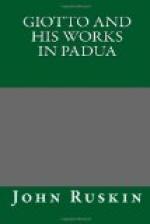This mountain background is also of great use in deepening the sense of gloom and danger on the desert road. The trees represented as growing on the heights have probably been rendered indistinct by time. In early manuscripts such portions are invariably those which suffer most; the green (on which the leaves were once drawn with dark colours) mouldering away, and the lines of drawing with it. But even in what is here left there is noticeable more careful study of the distinction between the trees with thick spreading foliage, the group of two with light branches and few leaves, and the tree stripped and dead at the bottom of the ravine, than an historical painter would now think it consistent with his dignity to bestow.
* * * * *
XX.
MASSACRE OF THE INNOCENTS.
Of all the series, this composition is the one which exhibits most of Giotto’s weaknesses. All early work is apt to fail in the rendering of violent action: but Giotto is, in this instance, inferior not only to his successors, but to the feeblest of the miniature-painters of the thirteenth century; while his imperfect drawing is seen at its worst in the nude figures of the children. It is, in fact, almost impossible to understand how any Italian, familiar with the eager gesticulations of the lower orders of his countrywomen on the smallest points of dispute with each other, should have been incapable of giving more adequate expression of true action and passion to the group of mothers; and, if I were not afraid of being accused of special pleading, I might insist at some length on a dim faith of my own, that Giotto thought the actual agony and strivings of the probable scene unfit for pictorial treatment, or for common contemplation; and that he chose rather to give motionless types and personifications of the soldiers and women, than to use his strength and realistic faculty in bringing before the vulgar eye the unseemly struggle or unspeakable pain. The formal arrangement of the heap of corpses in the centre of the group; the crowded standing of the mothers, as in a choir of sorrow; the actual presence of Herod, to whom some of them appear to be appealing,—all seem to me to mark this intention; and to make the composition only a symbol or shadow of the great deed of massacre, not a realisation of its visible continuance at any moment. I will not press this conjecture; but will only add, that if it be so, I think Giotto was perfectly right; and that a picture thus conceived might have been deeply impressive, had it been more successfully executed; and a calmer, more continuous, comfortless grief expressed in the countenances of the women. Far better thus, than with the horrible analysis of agony, and detail of despair, with which this same scene, one which ought never to have been made the subject of painting at all, has been gloated over by artists of more degraded times.




